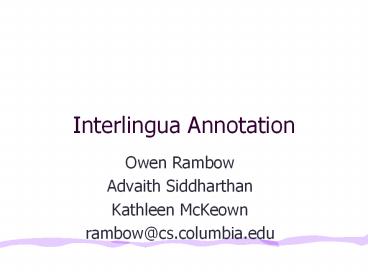Interlingua Annotation - PowerPoint PPT Presentation
Title:
Interlingua Annotation
Description:
... guidelines (methodology, manual) for annotating language ... Research: develop annotation scheme(s), methodology, manuals. Levels (reminder): (deep syntax) ... – PowerPoint PPT presentation
Number of Views:80
Avg rating:3.0/5.0
Title: Interlingua Annotation
1
Interlingua Annotation
- Owen Rambow
- Advaith Siddharthan
- Kathleen McKeown
- rambow_at_cs.columbia.edu
2
Goal
- Determine feasible deep semantic,
language-independent annotation (interlingua)
for text - Different from PropBank, FrameNet, WordNet these
projects are language-dependent
3
Expected Results
- Annotation guidelines (methodology, manual) for
annotating language-independent meaning
representation on texts in 7 languages - Methodology for porting to new languages
- Annotated corpora
4
Methodology
- Use source-language texts and multiple
translations into English - Develop successively more language-independent
levels of representation - (deep syntax)
- language-specific lexical disambiguation and
thematic structure (agent, theme, ) - language-independent representation
5
Methodology (2)
- Six sites (CMU, Columbia, ISI, Mitre, NMSU, UMd)
- Each site has one language Columbia Hindi
- Closer cooperation Columbia-UMd on Arabic and
Hindi - Division of tasks and expertise among sites
6
Methodology (3)
- Use annotators from beginning to test
inter-annotator agreement - Columbia have hired a native Hindi annotator
(near-native English) and an English-language
annotator
7
Research Issues
- Research develop annotation scheme(s),
methodology, manuals - Levels (reminder)
- (deep syntax)
- language-specific lexical disambiguation
- language-independent representation
- Questions
- Which levels do we annotate explicitly?
- What is included where?
- How do we annotate? Using which tools?
8
Timeline
- January develop language-specific disambiguation
- February-March annotate, measure
- April-June develop language-independent
annotation - July-August annotate, measure
- Year 2 review results, adjust annotation scheme
- Year 3 annotate
9
Arabic Dialects
- Owen Rambow
- (Nizar Habbash)
- rambow_at_cs.columbia.edu
10
Goal
- Investigate representation of linguistic
resources for closely related languages/dialects - Example Arabic
- Automatically derive NLP tools for cross-dialect
MT
11
Note on Arabic
- Interest Only one written dialect Modern
Standard Arabic (MSA), rarely spoken
spontaneously - Many spoken dialects, almost never written
- Dialects function of geography, urban/rural,
Bedouin/sedentary, sex, religion, - Code switching (mainly dialect-MSA) several
linguistic systems in same sentence - Challenge for traditional NLP approaches!
12
Expected Results
- Representation of phonology, lexicon, morphology,
and syntax for Modern Standard Arabic and
Egyptian Colloquial Arabic - Tools for converting between MSA and ECA
- Demonstration of tools in several domains (ECA
speech recognition, ECA -gt English translation)
13
Methodology
- Use existing scholarly resources to compile
sound-change rules, morphological
representations, syntactic representations - Use native speakers to validate, and augment
lexicon - Develop representation
- Develop automatic compilation of NLP tools
14
Timeline
- Sep-Dec start compiling sound change rules,
morphological rules, syntax - Jan-April develop representations for sound
change rules, morphology - Jan-Apr develop conversion rules
- May-August work on ECA speech recognition
application - Note also working on MSA syntax
- Year 2 extend to syntax, extend to second
dialect (Palestinian? Iraqi?)































